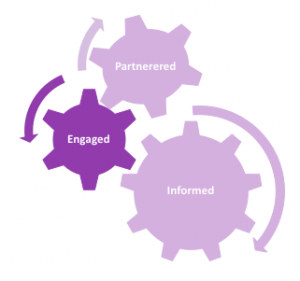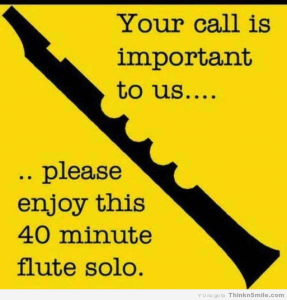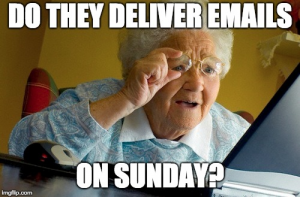PART 3 – The Life Of The Party: Everything You Need To Know About Managing Your Client
14 Chapter 14: Keep Your Client Engaged
 What do you do if you’ve sent several emails and haven’t heard back from your client? How do you overcome that fear of being a nuisance or pest when considering emailing just one more time? Or what about when your main stakeholders get pulled away onto bigger and more pressing company projects? What if your client goes through the dreaded organizational change or *gasp* asks to withdraw from your project?
What do you do if you’ve sent several emails and haven’t heard back from your client? How do you overcome that fear of being a nuisance or pest when considering emailing just one more time? Or what about when your main stakeholders get pulled away onto bigger and more pressing company projects? What if your client goes through the dreaded organizational change or *gasp* asks to withdraw from your project?
Perhaps you’re thinking, “We’ve got this, it won’t happen to us!” or maybe you look like a deer in the headlights right now. Either way, this chapter will help you take a proactive approach to mitigating and hopefully eliminating these challenges altogether.
Just in case you’d still like to get equipped to deal with these sort of issues if they do come about, we have you covered in Chapter 16. No need to cue the hold music.

Establish Formal Expectations
Being proactive means that you need to be active, as in doing some kind of work before hand to prevent yourself from falling into traps or sinkholes, in some cases. Start your client relationship on solid ground. Remember the contract, communications schedule, roles, etc. that we just discussed? These things were mentioned first because they’re essential in laying the groundwork for good client engagement. They’re kind of like setting up the ground rules to guide your relationship with the client. Notice we’ve used the word ‘ground’ a lot? That’s because these activities, much like tilling soil, when done right will help your client relationship ‘plant’ grow.
Start by ensuring that expectations are set upfront in terms of what you’ll deliver, how you’ll communicate, key milestone dates, what level and kind of engagement is needed, and be sure to include agreed upon response rate times somewhere. When chatting about deliverable schedules with your client, it’ll be worthwhile to outline what kind of information or help you might possibly need for those deliverables. And, when actually putting out requests to your client, give them enough time to get back to you. Sending a request via email at 8:43am on Friday and expecting to receive the goods by 5pm the same day is just not cool.

Communicate and Collaborate
The essence of CRM is fortifying client satisfaction, but the work should be 50/50. It’s a relationship of give and take, which is why communication is also extremely important. Working through the SoW or other project contracts, they can be intimidating, but treat them as discussions. In fact, it was suggested earlier that the creation of these documents should be done in working sessions between both sides as a collaboration. If, for example, a 24 hour response turnaround time is what you’re expecting, this should be discussed, agreed upon, and documented in the contract with your client.
Also, active communication is the best way to manage expectations. How can you ensure active communication? Simple – a continuous feedback loop. Emails and especially your weekly checkpoint meetings with the client are ripe opportunities to offer direct (ex- “we really struggled getting access to you last week”) or indirect (ex – “Since Mina didn’t send us the financial statements, we were unable to complete …”) feedback. You might also want to explore more formal/structured feedback methods like sending your client a survey at the end of the first and second semesters. Be mindful though – surveys should be short, easy to fill out, and should only ask opinions on things that you’re able and willing to change. See Part 5 for survey samples and templates.
Get Hyped
Lastly, remember that enthusiasm is contagious. Generally, if the client believes that you have a clear understanding of their challenges, that you’re committed to helping to address them and add value, and you’re making effective use of their time, then they’ll reciprocate.


Feedback/Errata